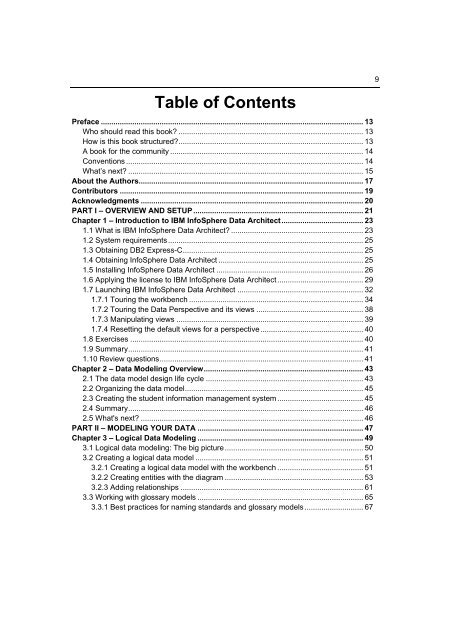Getting Started with InfoSphere Data Architect
Create successful ePaper yourself
Turn your PDF publications into a flip-book with our unique Google optimized e-Paper software.
Table of Contents<br />
Preface ............................................................................................................................. 13<br />
Who should read this book? ........................................................................................ 13<br />
How is this book structured? ........................................................................................ 13<br />
A book for the community ............................................................................................ 14<br />
Conventions ................................................................................................................. 14<br />
What’s next? ................................................................................................................ 15<br />
About the Authors ........................................................................................................... 17<br />
Contributors .................................................................................................................... 19<br />
Acknowledgments .......................................................................................................... 20<br />
PART I – OVERVIEW AND SETUP ................................................................................. 21<br />
Chapter 1 – Introduction to IBM <strong>InfoSphere</strong> <strong>Data</strong> <strong>Architect</strong> ....................................... 23<br />
1.1 What is IBM <strong>InfoSphere</strong> <strong>Data</strong> <strong>Architect</strong>? ............................................................... 23<br />
1.2 System requirements ............................................................................................. 25<br />
1.3 Obtaining DB2 Express-C ...................................................................................... 25<br />
1.4 Obtaining <strong>InfoSphere</strong> <strong>Data</strong> <strong>Architect</strong> ..................................................................... 25<br />
1.5 Installing <strong>InfoSphere</strong> <strong>Data</strong> <strong>Architect</strong> ...................................................................... 26<br />
1.6 Applying the license to IBM <strong>InfoSphere</strong> <strong>Data</strong> <strong>Architect</strong> ......................................... 29<br />
1.7 Launching IBM <strong>InfoSphere</strong> <strong>Data</strong> <strong>Architect</strong> ............................................................ 32<br />
1.7.1 Touring the workbench ................................................................................... 34<br />
1.7.2 Touring the <strong>Data</strong> Perspective and its views ................................................... 38<br />
1.7.3 Manipulating views ......................................................................................... 39<br />
1.7.4 Resetting the default views for a perspective ................................................. 40<br />
1.8 Exercises ............................................................................................................... 40<br />
1.9 Summary ................................................................................................................ 41<br />
1.10 Review questions ................................................................................................. 41<br />
Chapter 2 – <strong>Data</strong> Modeling Overview ............................................................................ 43<br />
2.1 The data model design life cycle ........................................................................... 43<br />
2.2 Organizing the data model ..................................................................................... 45<br />
2.3 Creating the student information management system ......................................... 45<br />
2.4 Summary ................................................................................................................ 46<br />
2.5 What's next? .......................................................................................................... 46<br />
PART II – MODELING YOUR DATA ............................................................................... 47<br />
Chapter 3 – Logical <strong>Data</strong> Modeling ............................................................................... 49<br />
3.1 Logical data modeling: The big picture .................................................................. 50<br />
3.2 Creating a logical data model ................................................................................ 51<br />
3.2.1 Creating a logical data model <strong>with</strong> the workbench ......................................... 51<br />
3.2.2 Creating entities <strong>with</strong> the diagram .................................................................. 53<br />
3.2.3 Adding relationships ....................................................................................... 61<br />
3.3 Working <strong>with</strong> glossary models ............................................................................... 65<br />
3.3.1 Best practices for naming standards and glossary models ............................ 67<br />
9

















